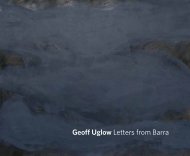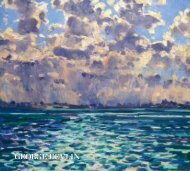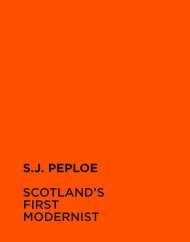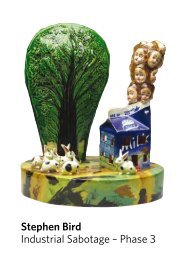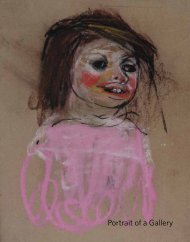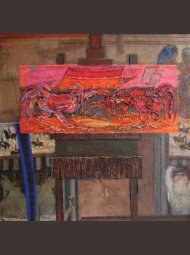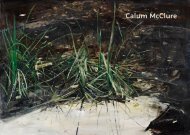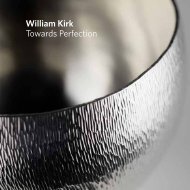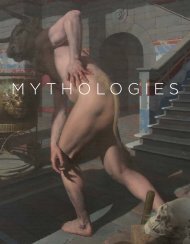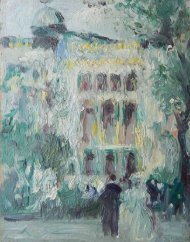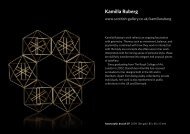Portrait of a Gallery - The Scottish Gallery
Portrait of a Gallery - The Scottish Gallery
Portrait of a Gallery - The Scottish Gallery
Create successful ePaper yourself
Turn your PDF publications into a flip-book with our unique Google optimized e-Paper software.
Prints<br />
An abiding memory <strong>of</strong> my first few days<br />
at <strong>The</strong> <strong>Scottish</strong> <strong>Gallery</strong> is being introduced<br />
to the Print Department by Ronnie Miller*.<br />
Solander box after solander box was taken<br />
out to show me – their heavy weight, the<br />
texture <strong>of</strong> their binding, the slap <strong>of</strong> their<br />
lids on the counter, then revealed, leafed<br />
between acid-free tissue and mounted on<br />
acid-free board, were original etchings by<br />
Rembrandt, landscape capriccios from Paul<br />
Sandby, miniature etchings by John Clerk <strong>of</strong><br />
Eldin, velvety mezzotints after portraits by<br />
Henry Raeburn, dark, iconic landscapes from<br />
DY Cameron, some etched joie de vivre from<br />
Anthony Gross, or charmingly ‘primitive’ 17th<br />
century maps by Johannes Blaeu. In adjacent<br />
print cabinets were found more recent,<br />
larger works – lithographs by Colquhoun and<br />
MacBryde, etchings from Julian Trevelyan and<br />
John Piper, screenprints by Patrick Heron or<br />
Robyn Denny, and others by David Hockney,<br />
Eduardo Paolozzi, Norman Ackroyd, Elizabeth<br />
Frink and a host <strong>of</strong> contemporary <strong>Scottish</strong><br />
printmakers. Clearly, the Print Department<br />
<strong>of</strong> 1987 represented the gallery at its most<br />
eclectic!<br />
<strong>The</strong> <strong>Scottish</strong> <strong>Gallery</strong> has had a long and<br />
fruitful relationship with printmaking, as<br />
dealers, exhibitors and at times, publishers.<br />
In the 1890s Aitken Dott and Sons published<br />
a number <strong>of</strong> steel engravings after popular<br />
paintings, such as ‘<strong>The</strong> Meeting <strong>of</strong> Burns and<br />
Scott’ by Charles Hardie. At the same time,<br />
and for many years to come, the company<br />
held large stocks <strong>of</strong> antiquarian prints –<br />
etchings by Albrecht Dürer, engravings from<br />
Le Vedute di Roma by Piranesi, 18th Century<br />
caricatures from George Cruikshank, etchings<br />
<strong>of</strong> Paris by Charles Meryon or William<br />
Daniell’s 1820s aquatints from A Voyage Round<br />
Great Britain, among many, many others.<br />
62<br />
Alongside works from the past, the Print<br />
Department <strong>of</strong> 1900 was well stocked with<br />
contemporary artists, etching pioneers such<br />
as American James Abbott McNeil Whistler,<br />
the Swede Anders Zorn, Scotsman William<br />
Strang and Frenchman Alphonse Legros.<br />
<strong>The</strong> Edwardian era through to the second<br />
war saw a great vogue for the freedom <strong>of</strong> line<br />
and monochrome textures <strong>of</strong> etchings, which,<br />
with wide-margined mounts and narrow<br />
black frames, graced many a fashionable<br />
interior <strong>of</strong> the period. Many <strong>of</strong> the finest<br />
exponents <strong>of</strong> etching were Scots, (to such<br />
an extent that etching was regarded almost<br />
as a national art form) epitomised by the<br />
avidly collected work <strong>of</strong> Muirhead Bone,<br />
James McBey, DY Cameron and ES Lumsden,<br />
all <strong>of</strong> whom were exhibited by the gallery.<br />
Despite this local pre-eminence, non-Scots<br />
continued to be stocked – Frank Brangwyn,<br />
GL Brockhurst, Edmund Blampied, Robert<br />
Austin and Laura Knight, to name but a few.<br />
<strong>Gallery</strong> records show that its publication <strong>of</strong><br />
a series <strong>of</strong> original etchings by Joseph Gray<br />
in the late 20s proved highly successful, with<br />
prints selling rapidly to collectors in New York,<br />
Philadelphia, Chicago and London.<br />
Concurrent with the interwar boom<br />
in etching was a growing appreciation<br />
for woodblock printing, inspired by the<br />
Japanese and filtered through French Post-<br />
Impressionism. In 1911 the gallery had shown<br />
woodblock prints by Hokusai and Utamaro,<br />
and artists such as Charles Hodge Mackie<br />
and Mabel Royds, who were inspired by such<br />
masters, later showed with the gallery.<br />
With post-war austerity many artists<br />
and dealers saw printmaking as a more<br />
affordable way <strong>of</strong> bringing original<br />
contemporary art to a wider audience.<br />
In the 1940s and 50s this idea in part



